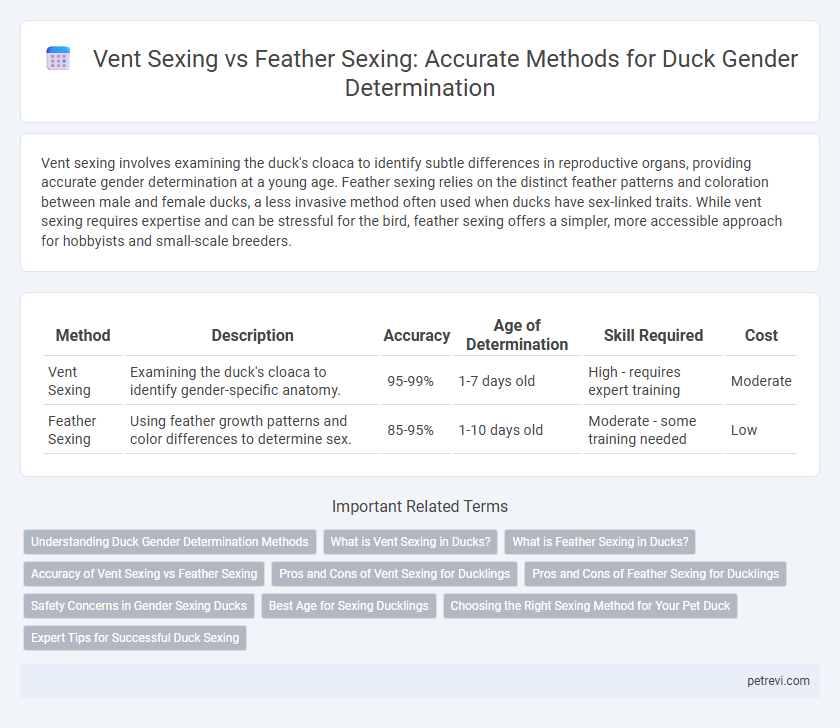Vent sexing involves examining the duck's cloaca to identify subtle differences in reproductive organs, providing accurate gender determination at a young age. Feather sexing relies on the distinct feather patterns and coloration between male and female ducks, a less invasive method often used when ducks have sex-linked traits. While vent sexing requires expertise and can be stressful for the bird, feather sexing offers a simpler, more accessible approach for hobbyists and small-scale breeders.
Table of Comparison
| Method | Description | Accuracy | Age of Determination | Skill Required | Cost |
|---|---|---|---|---|---|
| Vent Sexing | Examining the duck's cloaca to identify gender-specific anatomy. | 95-99% | 1-7 days old | High - requires expert training | Moderate |
| Feather Sexing | Using feather growth patterns and color differences to determine sex. | 85-95% | 1-10 days old | Moderate - some training needed | Low |
Understanding Duck Gender Determination Methods
Vent sexing and feather sexing are two primary methods used for determining duck gender, each with distinct advantages in accuracy and ease of application. Vent sexing involves examining the internal reproductive organs through the cloaca, providing highly accurate results but requiring skilled handlers, while feather sexing relies on observing the pattern and length of wing feathers in ducklings, offering a non-invasive and quicker alternative suitable for large-scale operations. Selecting the appropriate method depends on factors such as age, species, and operational scale, with vent sexing preferred for precision and feather sexing favored for efficiency.
What is Vent Sexing in Ducks?
Vent sexing in ducks involves examining the cloaca (vent) to identify the presence of a tiny genital organ called a phallus, which indicates a male duck (drake). This precise method enables breeders to determine gender at a very early age, often within the first few days after hatching. Unlike feather sexing, vent sexing requires more expertise and careful handling to avoid injury to the ducklings while providing accurate sex identification.
What is Feather Sexing in Ducks?
Feather sexing in ducks is a technique used to determine the sex of ducklings by examining the length and pattern of their wing feathers shortly after hatching. This method relies on the differences in primary and secondary feather growth rates between males and females, where females typically exhibit longer primary feathers compared to males. Feather sexing offers a quick, non-invasive, and reliable alternative to vent sexing, enabling early gender identification for better flock management and breeding decisions.
Accuracy of Vent Sexing vs Feather Sexing
Vent sexing offers higher accuracy in determining duck gender, with experienced practitioners achieving over 95% precision by examining the genital papilla within the cloaca. Feather sexing, while less invasive and quicker, generally provides around 85-90% accuracy by assessing feather development patterns, which can vary among duck breeds. The choice between methods depends on the need for precision versus ease and speed in gender identification.
Pros and Cons of Vent Sexing for Ducklings
Vent sexing offers rapid and reliable identification of duckling gender by examining the genital papilla, providing accuracy even in newly hatched ducklings. However, this method requires skilled personnel to minimize stress and injury risks to the delicate ducklings, and its invasive nature can lead to higher handling time compared to non-invasive methods. Despite these challenges, vent sexing remains a preferred technique in commercial breeding for its precision during early developmental stages.
Pros and Cons of Feather Sexing for Ducklings
Feather sexing allows for immediate gender identification in ducklings by examining wing feather patterns, providing quick and non-invasive results beneficial for commercial duck farming. However, feather sexing requires trained personnel and is not universally accurate across all duck breeds, leading to potential misidentification. This method is more cost-effective compared to vent sexing but may yield lower precision, impacting breeding and management decisions.
Safety Concerns in Gender Sexing Ducks
Vent sexing and feather sexing are the primary methods used to determine duck gender, each presenting distinct safety considerations for both the animal and handler. Vent sexing, involving physical examination of the cloaca, requires trained personnel due to risks of injury and stress to the duck, whereas feather sexing relies on visible secondary sexual characteristic patterns, minimizing direct contact and lowering the risk of harm. Ensuring proper training and handling protocols is critical to maintain animal welfare and accurate sex identification in duck farming practices.
Best Age for Sexing Ducklings
The best age for vent sexing ducklings is typically within the first 1 to 3 days after hatching, as the genitalia are more distinguishable but still require expert handling. Feather sexing becomes effective around 5 to 7 days of age when primary and secondary wing feathers develop at different rates between males and females. Early and accurate sex determination methods optimize flock management and breeding efficiency in commercial duck production.
Choosing the Right Sexing Method for Your Pet Duck
Vent sexing offers precise accuracy in determining the gender of young ducks by examining their cloacal structures, making it ideal for experienced handlers who require early and reliable results. Feather sexing provides a less invasive alternative by identifying gender based on the patterns and timing of feather growth, suitable for owners seeking a gentler method without specialized training. Choosing the right sexing method depends on balancing accuracy, invasiveness, and the handler's expertise to ensure the best care and management of your pet duck.
Expert Tips for Successful Duck Sexing
Expert tips for successful duck sexing emphasize accuracy and timing, with vent sexing requiring skilled handling to gently identify genitalia in day-old ducklings. Feather sexing offers a less invasive alternative by examining wing feather length differences, effective primarily in specific duck breeds like Khaki Campbell and Khaki Indian Runner. Combining both methods and consulting experienced breeders enhances gender determination accuracy, ensuring proper flock management and breeding outcomes.
Vent Sexing vs Feather Sexing for Duck gender determination Infographic

 petrevi.com
petrevi.com